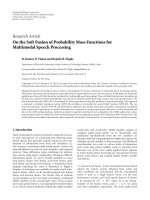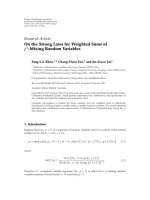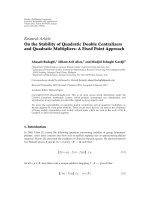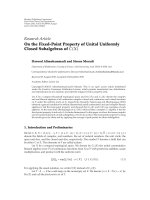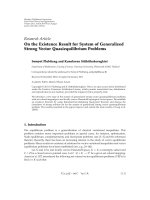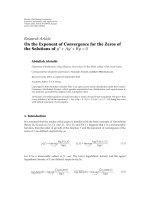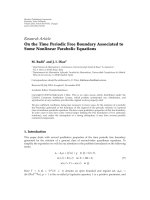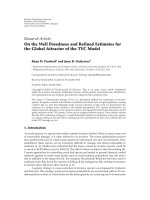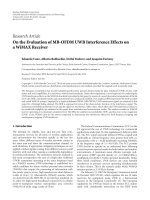Báo cáo hóa học: " Research Article On the Integrability of Quasihomogeneous Systems and Quasidegenerate Infinity Systems" pot
Bạn đang xem bản rút gọn của tài liệu. Xem và tải ngay bản đầy đủ của tài liệu tại đây (514.96 KB, 10 trang )
Hindawi Publishing Corporation
Advances in Difference Equations
Volume 2007, Article ID 98427, 10 pages
doi:10.1155/2007/98427
Research Article
On the Integrability of Quasihomogeneous Systems and
Quasidegenerate Infinity Systems
Yanxia Hu
Received 9 February 2007; Accepted 21 May 2007
Recommended by Kilkothur Munirathinam Tamizhmani
The integrability of quasihomogeneous systems is considered, and the properties of the
first integrals and the inverse integrating factors of such systems are shown. By solving
the systems of ordinary differential equations which are established by using the vector
fields of the quasihomogeneous systems, one can obtain an inverse integrating factor of
the systems. Moreover, the integrability of a class of systems (quasidegenerate infinity
systems) which generalize the so-called degenerate infinity vector fields is considered,
and a method how to obtain an inverse integrating factor of the systems from the first
integrals of the corresponding quasihomogeneous systems is shown.
Copyright © 2007 Yanxia Hu. This is an open access article distributed under the Cre-
ative Commons Attribution License, which permits unrestricted use, distribution, and
reproduction in any medium, provided the original work is properly cited.
1. Introduction
We consider quasihomogeneous autonomous systems, which are also called similarity
invariant systems or weighted homogeneous systems, that is, the following nth order au-
tonomous system of differential equations:
dx
i
dt
= X
i
(x), i = 1,2, ,n, (1.1)
where x
= (x
1
,x
2
, ,x
n
) ∈ D ⊂ R
n
(or C
n
), X
i
: D → R (or C), X
i
∈ C
∞
(D), and t ∈ R (or
C). System (1.1) i s invariant under the similarity transformation x = (x
1
,x
2
, ,x
n
,t) →
(α
p
1
x
1
,α
p
2
x
2
, ,α
p
n
x
n
,α
−l
t)forallα ∈ R \{0},wherep
1
, p
2
, , p
n
and l are positive inte-
gers. In other words, X
i
(x)arep
i
(i = 1,2, ,n) quasihomogeneous functions of weighted
degrees p
i
+ l, respectively, that is,
X
i
α
p
1
x
1
, ,α
p
n
x
n
=
α
p
i
+l
X
i
x
1
, ,x
n
(1.2)
2AdvancesinDifference Equations
for all α
∈ R \{0}. We also say that system (1.1)isp
i
(i = 1,2, ,n) quasihomogeneous
of weighted degree l.
Notice that if p
i
(i = 1,2, ,a)areevenandp
i
(i = a +1,a +2, ,n)andl are odd, then
the p
i
(i = 1,2, ,n) quasihomogeneous systems include some class of the reversible sys-
tems which are invariant under the symmetry (x
1
, ,x
n
,t) → (x
1
, ,x
a
,−x
a+1
, ,−x
n
,t).
Moreover, in the particular case p
i
(i = 1,2, ,n) = 1, the quasihomogeneous systems re-
duce to classical homogeneous systems.
Motion equations of many important problems of dynamics are of the quasihomo-
geneous form, for example, Euler-Poisson equations, Kirchhoff equations, and so forth.
Recently, several works have studied the integrability of autonomous systems and quasi-
homogeneous polynomial systems; for more details see [1–6]. In [5], several techniques
for searching first integrals of nth autonomous systems by using Lie groups admitted
by the systems are proposed. The integrability of quasihomogeneous planar systems is
studied in [1, 3], and the existence of a link between the Kowalevskaya exponents of
quasihomogeneous systems and the degree of their quasihomogeneous polynomial first
integralsisstudiedin[2, 4]. There exist some methods for studying the integrability
of autonomous systems by using Lie group admitted by the systems [5, 7, 8]andus-
ing by the invariant manifolds of the systems [6]. As we know, the existence of inverse
integrating factors gives a lot of information on dynamics, integrability of the systems
and so on. In [9], the relationship between the property of a Darboux first integral
and the existence of a polynomial inverse integrating factor of a polynomial differen-
tial systems was studied. However, generally, it is difficult to search for inverse integrat-
ing factors. Searching for first integrals of a system plays a very important role for in-
tegrating the system. In this paper, we study the integrability of nth order qusaihomo-
geneous systems. First, we show the properties of the first integrals and the inverse i n-
tegrating factors of such systems. Then, we propose a method to obtain an inverse in-
tegrating factor of the systems by solving the ordinary differential equations systems es-
tablished by using the vector fields of the quasihomogeneous systems. System (1.1)with
n
= 2 is called degenerate infinity system if it satisfies X
1
= x
1
A, X
2
= x
2
A for some ho-
mogeneous polynomial A(x
1
,x
2
). Degenerate infinity systems have attr acted the atten-
tion of many authors, see [10, 11]. In this paper, we also consider the integrability of
a class of systems which generalize the so-called degenerate infinity vector fields, that
is,
dx
i
dt
= X
i
(x)+p
i
x
i
A
x
1
,x
2
, ,x
n
, i = 1,2, ,n, (1.3)
where X
i
(x)(i = 1,2, ,n)arep
i
(i = 1,2, ,n) quasihomogeneous function of weighted
degrees p
i
+ l of system (1.1), respectively. A(x
1
,x
2
, ,x
n
)isgivenap
i
(i = 1,2, ,n)
quasihomogeneous polynomial of weighted degree α.Wecallsystem(1.3) a quasidegen-
erate infinity system. We propose a method to obtain inverse integrating factors of system
(1.3) from the first integrals of the corresponding quasihomogeneous system (1.1)byus-
ing the Darboux’s theory of integrability.
Yan x i a Hu 3
2. On the integrability of quasihomogeneous systems
Let X be the vector field associated with system (1.1), that is,
X
= X
1
(x)
∂
∂x
1
+ X
2
(x)
∂
∂x
2
+ ···+ X
n
(x)
∂
∂x
n
. (2.1)
Let G be a one-parameter Lie group with an associated infinitesimal generator V defined
as
V
= ξ
1
(x)
∂
∂x
1
+ ξ
2
(x)
∂
∂x
2
+ ···+ ξ
n
(x)
∂
∂x
n
, (2.2)
where ξ
i
(x) ∈ C
1
(D), i = 1, 2, ,n. A Lie group admitted by (in fact an infinitesimal sym-
metry) system (1.1) is defined to be a group of transformations with infinitesimal genera-
tor V such that under the action of this group, a solution curve of system (1.1)ismapped
into another solution curve of system (1.1).
Proposition 2.1 (see [7]). Let G be the one-parameter Lie group with infinitesimal gener-
ator V, then G is a Lie group admitted by system (1.1)ifandonlyif
[X,V]
= B
x
1
,x
2
, ,x
n
X (2.3)
issatisfiedforsomesmoothscalarfunctionB(x
1
,x
2
, ,x
n
), where [X,V]:= XV − VX is
the Lie bracket of the C
1
-vector fields of X and V.
Definit ion 2.2. Let ᐂ be an open subset of D. A nonzero function μ
∈ C
1
(ᐂ):ᐂ → R,
satisfying the linear partial differential equation Xμ
= div(X)μ, or equivalently,
X
1
(x)
∂μ
∂x
1
+ X
2
(x)
∂μ
∂x
2
+ ···+ X
n
(x)
∂μ
∂x
n
=
∂X
1
∂x
1
+ ···+
∂X
n
∂x
n
μ, (2.4)
is called an inverse integrating factor of system (1.1)onᐂ.Itiswellknown,ifn
= 2,
system (1.1) has two autonomous differential equations and admits a Lie group G,then
the system (1.1) has the following inverse integrating factor defined on ᐂ:
μ
x
1
,x
2
=
X
1
x
1
,x
2
ξ
2
x
1
,x
2
−
X
2
x
1
,x
2
ξ
1
x
1
,x
2
(2.5)
provided that μ(x
1
,x
2
) = 0 (see [8]).
Theorem 2.3. System (1.1)admitstheLiegroupG with the following infinitesimal genera-
tor V:
V
= p
1
x
1
∂
∂x
1
+ ···+ p
n
x
n
∂
∂x
n
. (2.6)
Proof. One can obtain the result by straightforward computing by using Proposition 2.1 .
For example, the system of Euler-Poisson equations is a quasihomogeneous system
with
p
1
= p
2
= p
3
= 1, p
4
= p
5
= p
6
= 2, l = 1, (2.7)
4AdvancesinDifference Equations
and it admits Lie group with infinitesimal generator V,
V
= x
1
∂
∂x
1
+ x
2
∂
∂x
2
+ x
3
∂
∂x
3
+2x
4
∂
∂x
4
+2x
5
∂
∂x
5
+2x
6
∂
∂x
6
. (2.8)
In [5], some first integrals of the Euler-Poisson equations system are obtained by using
the quasihomogeneous propert y of the system.
It is well known that, given a polynomial f
∈ R[x
1
,x
2
, ,x
n
], we can split it in the
form f
= f
m
+ f
m+1
+ ···+ f
m+r
,where f
k
(k = m,m +1, , m + r)isap
i
(i = 1,2, ,n)
quasihomogeneous polynomial of weighted deg ree k, that is,
f
k
α
p
1
x
1
, ,α
p
n
x
n
=
α
k
f
k
x
1
, ,x
2
(2.9)
for k
= m,m +1, ,m + r. We have the following result.
Theorem 2.4. Let f be a polynomial in the variables x
1
,x
2
, ,x
n
and let
f
= f
m
+ f
m+1
+ ···+ f
m+r
(2.10)
be its decomposition into p
i
(i = 1,2, ,n) quasihomogeneous polynomial of weighted degree
m + i for i
= 0,1, ,r, then f is either a polynomial first integral or a polynomial inverse
integrating factor of system (1.1) if and only if each quasihomogeneous polynomial f
m+i
is
either a first integral or an integrating factor of system (1.1)fori
= 0,1, ,r, respectively.
Proof. If f is a polynomial first integral, the result is proved in [4]. Hence we will proof
thecaseinwhich f is a polynomial inverse integr ating factor of system (1.1).
The sufficiency is obvious. So we will only prove the necessity. From Definition 2.2,we
have
X
1
(x)
∂f
∂x
1
+ X
2
(x)
∂f
∂x
2
+ ···+ X
n
(x)
∂f
∂x
n
=
∂X
1
∂x
1
+ ···+
∂X
n
∂x
n
f , (2.11)
that is,
r
i=0
X
1
(x)
∂f
m+i
∂x
1
+ X
2
(x)
∂f
m+i
∂x
2
+ ···+ X
n
(x)
∂f
m+i
∂x
n
=
r
i=0
∂X
1
∂x
1
+
∂X
2
∂x
2
+ ···+
∂X
n
∂x
n
f
m+i
.
(2.12)
Since X
j
(x)(j = 1,2, ,n)haveweightdegreesp
j
+ l (j = 1,2, ,n), then the divergence
of system (1.1)
divX
=
∂X
1
∂x
1
+
∂X
2
∂x
2
+ ···+
∂X
n
∂x
n
, (2.13)
has weighted degree l. Similarly, ∂f
m+i
/∂x
j
( j = 1, 2, ,n)haveweighteddegreesm + i −
p
j
( j = 1,2, ,n), respectively. So, from the quasihomogeneous polynomial components
on the left- and right-hand sides of being of weighted degree l + m + i,wecanobtain
X
1
(x)
∂f
m+i
∂x
1
+ X
2
(x)
∂f
m+i
∂x
2
+ ···+ X
n
(x)
∂f
m+i
∂x
n
=
∂X
1
∂x
1
+
∂X
2
∂x
2
+ ···+
∂X
n
∂x
n
f
m+i
,
(2.14)
Yan x i a Hu 5
where i
= 0,1, ,r. Consequently, f
m+i
is an inverse integrating factor of system (1.1)and
hence this completes the proof.
From Theorem 2.4, in order to study either polynomial first integrals or polynomial
inverse integrating factors of quasihomogeneous p olynomial system, we need only to
consider quasihomogeneous polynomial functions.
Theorem 2.5. Any inverse integrating factor of system (1.1) is a quasihomoge neous func-
tion. Moreover, if
X
i
− w
i
X
1
p
i
p
1
= 0(i = 2,3, ,n),
div
X − X
1
m
p
1
= 0,
(2.15)
where
X
i
= X
i
(1,w
2
,w
3
, ,w
n
), then w
m/p
1
1
f
m
is an inverse integrating factor of weighted
degree m of system (1.1), where
f
m
= f
m
(1,w
2
,w
3
, ,w
n
) satisfies the following equations:
dw
2
X
2
−
p
2
/p
1
w
2
X
1
=
dw
3
X
3
−
p
3
/p
1
w
3
X
1
=···=
dw
n
X
n
−
p
n
/p
1
w
n
X
1
=
f
m
divX −
m/p
1
X
1
.
(2.16)
Proof. Let f (x
1
, ,x
n
) be an inverse integrating factor of system (1.1), that is,
X
1
∂f
∂x
1
+ X
2
∂f
∂x
2
+ ···+ X
n
∂f
∂x
n
=
∂X
1
∂x
1
+
∂X
2
∂x
2
+ ···+
∂X
n
∂x
n
f , (2.17)
because X
1
, ,X
n
and div X are quasihomogeneous functions of weighted degrees p
1
+
l, , p
n
+ l and l, respectively. It is not difficult to obtain that (2.17)isinvariantundera
change of (x
1
,x
2
, ,x
n
) → (α
p
1
x
1
,α
p
2
x
2
, ,α
p
n
x
n
). Consequently, their solutions are also
invariant, that is,
f
α
p
1
x
1
, ,α
p
n
x
n
=
f
x
1
, ,x
n
(2.18)
or
f
α
p
1
x
1
, ,α
p
n
x
n
=
α
m
f
x
1
, ,x
n
. (2.19)
So f is a p
1
, , p
n
quasihomogeneous function (of weighted degree m).
Letting f
m
(x
1
, ,x
n
) be a quasihomogeneous function of weighted degree m,wehave
f (α
p
1
x
1
, ,α
p
n
x
n
) = α
m
f (x
1
, ,x
n
). If f
m
is an inverse integrating factor of system (1.1),
then the following equation holds:
X
1
∂f
m
∂x
1
+ X
2
∂f
m
∂x
2
+ ···+ X
n
∂f
m
∂x
n
= (divX) f
m
. (2.20)
6AdvancesinDifference Equations
Now, let
w
1
= x
1
, w
2
=
x
2
x
p
2
/p
1
1
, ,w
n
=
x
n
x
p
n
/p
1
1
, (2.21)
then,
X
i
x
1
, ,x
n
=
X
i
w
1
,w
2
w
p
2
/p
1
1
, ,w
n
w
p
n
/p
1
1
=
w
(p
i
+l)/p
1
1
X
i
1,w
2
, ,w
n
=
w
(p
i
+l)/p
1
1
X
i
, i = 1,2, ,n,
divX
x
1
, ,x
n
=
divX
w
1
,w
2
w
p
2
/p
1
1
, ,w
n
w
p
n
/p
1
1
=
w
l/p
1
1
divX
1,w
2
, ,w
n
=
w
l/p
1
1
divX.
(2.22)
On the other hand, by the chain rule of the derivative, in the new variables w
1
,w
2
, ,w
n
,
(2.20)becomes
w
(p
1
+l)/p
1
1
X
1
∂f
m
w
1
,w
2
w
p
2
/p
1
1
, ,w
n
w
p
n
/p
1
1
∂x
1
+ w
(p
2
+l)/p
1
1
X
2
∂f
m
w
1
,w
2
w
p
2
/p
1
1
+ ···+ w
n
w
p
n
/p
1
1
∂x
2
+ ···+ w
(p
n
+l)/p
1
1
X
n
∂f
m
w
1
,w
2
w
p
2
/p
1
1
, ,w
n
w
p
n
/p
1
1
∂x
n
=
w
l/p
1
1
divX
f
m
w
1
,w
2
w
p
2
/p
1
1
, ,w
n
w
p
n
/p
1
1
.
(2.23)
Based on the following formulas:
f
m
w
1
,w
2
w
p
2
/p
1
1
, ,w
n
w
p
n
/p
1
1
=
w
m/p
1
1
f
m
1,w
2
, ,w
n
=
w
m/p
1
1
f
m
, (2.24)
∂f
m
∂x
1
=
m
p
1
w
(m/p
1
)−1
f
m
−
p
2
p
1
w
2
w
1
w
m/p
1
1
∂ f
m
∂w
2
−···−
p
n
p
1
w
n
w
1
w
m/p
1
1
∂ f
m
∂w
n
,
∂f
m
∂x
i
= w
−(m−p
i
)/P
1
1
∂ f
m
∂w
i
, i = 2, ,n,
(2.25)
(2.23)becomes
X
2
−
p
2
p
1
w
2
X
1
∂ f
m
∂w
2
+ ···+
X
n
−
p
n
p
1
w
n
X
1
∂ f
m
∂w
n
=
divX −
m
p
1
X
1
f
m
. (2.26)
Obviously, its characteristic equation is (2.16). So
f
m
satisfies (2.16). According to the
formula (2.24), this completes the proof.
Example 2.6. We consider the following system:
dx
dt
= axy,
dy
dt
= bx
3
+ cy
2
. (2.27)
Yan x i a Hu 7
This system is a p
1
= 2, p
2
= 3 quasihomogeneous polynomial system of weighted degree
3, and i t is invariant under the similarity transformation
(x, y,t)
−→
α
2
x, α
3
y,α
−3
t
. (2.28)
It is easy to get the following formulas:
X
1
= X
1
1,w
2
=
aw
2
,
X
2
= X
2
1,w
2
=
b + cw
2
2
,
div
X = div X
1,w
2
=
(a +2c)w
2
.
(2.29)
From (2.16), we have
dw
2
b +
c − (3/2)a
w
2
2
=
d f
m
−
ma/2 − a− 2c
w
2
f
m
. (2.30)
Its solution is
f
m
= c
b +
c −
3
2
a
w
2
2
(−ma/2−a−2c)/(2c−3a)
. (2.31)
So
f
m
1,
y
x
3/2
=
c
b +
c −
3
2
a
y
2
x
3
(−ma/2−a−2c)/(2c−3a)
. (2.32)
Based on Theorem 2.5, we can get an inverse integrating factor
x
m/2
b +
c −
3
2
a
y
2
x
3
(−ma/2−a−2c)/(2c−3a)
(2.33)
of the system. Specially, when m
= 2, the inverse integrating factor is
x
b +
c −
3
2
a
y
2
x
3
(−2a−2c)/(2c−3a)
. (2.34)
3. On the integrability of quasidegener ate infinity systems
We consider the quasidegenerate infinity system (1.3).
Lemma 3.1. Let X
∗
= (X
1
+ p
1
x
1
A(x
1
,x
2
, ,x
n
))(∂/∂x
1
)+··· +(X
n
+ p
n
x
n
A(x
1
,
x
2
, ,x
n
))(∂/∂x
n
) be the vector field associated with system (1.3)andletΩ(x
1
,x
2
,
,x
n
) be a quasihomogeneous first integral of weighted degree d of system (1.1), then
X
∗
Ω = dA
x
1
,x
2
, ,x
n
Ω. (3.1)
8AdvancesinDifference Equations
Proof. The derivative of Ω(x
1
,x
2
, ,x
n
) along the orbits of system (1.3)is
X
∗
Ω =
∂Ω
∂x
1
X
1
+ p
1
x
1
A
+
∂Ω
∂x
2
X
2
+ p
2
x
2
A
+ ···+
∂Ω
∂x
n
X
n
+ p
n
x
n
A
=
∂Ω
∂x
1
X
1
+
∂Ω
∂x
2
X
2
+ ···+
∂Ω
∂x
n
X
n
+ A
p
1
x
1
∂Ω
∂x
1
+ ···+ p
n
x
n
∂Ω
∂x
n
=
A
p
1
x
1
∂Ω
∂x
1
+ ···+ p
n
x
n
∂Ω
∂x
n
.
(3.2)
Based on the generalized Euler’s theorem for quasihomogeneous function, we have
p
1
x
1
∂Ω
∂x
1
+ ···+ p
n
x
n
∂Ω
∂x
n
= dΩ. (3.3)
So, (3.2)becomes
X
∗
Ω = dAΩ. (3.4)
Lemma 3.2. Let f (x
1
, ,x
n
) be a quasihomogeneous inverse integrating factor of weighted
degree m of system (1.1), then f (x
1
, ,x
n
) is a quasihomogeneous invariant manifold of
system (1.3).
Proof. Because f (x
1
, ,x
n
) is an inverse integrating factor of system (1.1), we have
X
1
∂f
∂x
1
+ ···+ X
n
∂f
∂x
n
=
∂X
1
∂x
1
+ ···+
∂X
n
∂x
n
f. (3.5)
The derivative of f (x
1
, ,x
n
) along the orbits of system (1.3)is
X
∗
f =
∂f
∂x
1
X
1
+ p
1
x
1
A
+
∂f
∂x
2
X
2
+ p
2
x
2
A
+ ···+
∂f
∂x
n
X
n
+ p
n
x
n
A
=
∂f
∂x
1
X
1
+
∂f
∂x
2
X
2
+ ···+
∂f
∂x
n
X
n
+ A
p
1
x
1
∂f
∂x
1
+ ···+ p
n
x
n
∂f
∂x
n
=
(divX) f + mA f.
(3.6)
The last term of the above expression can be obtained by using the generalized Euler’s
theorem for quasihomogeneous function. So
X
∗
f = (divX + mA) f , (3.7)
that is, f (x
1
,x
2
, ,x
n
) = 0 is an invariant manifold of system (1.3).
Theorem 3.3. Let Ω(x
1
,x
2
, ,x
n
) be a quasihomogeneous first integral of weighted degree
d of system (1.1), then Ω
(α−l)/d
f is an inverse integrating factor of system (1.3).
Yan x i a Hu 9
Proof. First, we calculate the divergence of system (1.3):
divX
∗
=
∂
∂x
1
X
1
+ p
1
x
1
A
+
∂
∂x
2
X
2
+ p
2
x
2
A
+ ···+
∂
∂x
n
X
n
+ p
n
x
n
A
=
∂X
1
∂x
1
+
∂X
2
∂x
2
+···+
∂X
n
∂x
n
+
p
1
x
1
∂A
∂x
1
+···+ p
n
x
n
∂A
∂x
n
+A
p
1
+ p
2
+···+ p
n
=
divX + A
p
1
+ p
2
+ ···+ p
n
+ α
.
(3.8)
On the other hand, from the proves of Lemmas 3.1 and 3.2,wehave
X
∗
Ω = dAΩ,
X
∗
f = (divX + mA) f.
(3.9)
Let
K
1
x
1
,x
2
, ,x
n
=
dA,
K
2
x
1
,x
2
, ,x
n
=
divX + A
p
1
+ p
2
+ ···+ p
n
+ l
.
(3.10)
So, we can find two constants λ
1
and λ
2
such that
n
i=1
λ
i
K
i
x
1
,x
2
, ,x
n
=
divX
∗
, (3.11)
that is, λ
1
= (α − l)/d and λ
2
= 1. Therefore, applying the Darboux’s theory of integra-
bility (see [12]), we obtain that the function Ω
(α−l)/d
f is an inverse integrating factor of
system (1.3).
4. Conclusion
In this paper, we have studied the integrability of quasihomogeneous systems. From the
above investigation, we see that the properties of quasihomogeneous systems may help us
in studying the integrability of the systems. We need only to consider quasihomogeneous
polynomial functions in order to study either polynomial first integrals or polynomial
inverse integrating factors of quasihomogeneous systems. Specially, we have proposed a
method to obtain an inverse integrating factor of the systems on the base of the systems of
ordinary differential equations established by using the quasihomogeneous vector fields.
Moreover, we also have considered quasidegenerate infinity systems, and shown how to
obtain an inverse integrating factor from the first integrals of the corresponding quasiho-
mogeneous systems by using Darboux’s theory of integrability.
Acknowledgment
This research was supported by the National Natural Science Foundation of China (No.
10626018) and the foundation from North China Electric Power University.
10 Advances in Difference Equations
References
[1] J.Chavarriga,I.A.Garc
´
ıa, and J. Gin
´
e, “On integrability of differential equations defined by the
sum of homogeneous vector fields with degenerate infinity,” International Journal of Bifurcation
and Chaos, vol. 11, no. 3, pp. 711–722, 2001.
[2] A. Goriely, “Integrability, partial integrability, and nonintegrability for systems of ordinary dif-
ferential equations,” Journal of Mathematical Physics, vol. 37, no. 4, pp. 1871–1893, 1996.
[3] I.A.Garc
´
ıa, “On the integrability of quasihomogeneous and related planar vector fields,” Inter-
national Journal of Bifurcation and Chaos, vol. 13, no. 4, pp. 995–1002, 2003.
[4] J. Llibre and X. Zhang, “Polynomial first integrals for quasi-homogeneous polynomial differen-
tial systems,” Nonlinearity, vol. 15, no. 4, pp. 1269–1280, 2002.
[5] Y. Hu and K. Guan, “Techniques for searching first integrals by Lie group and application to
gyroscope system,” Science in China. Series A, vol. 48, no. 8, pp. 1135–1143, 2005.
[6] Y. Hu and X. Yang, “A method for obtaining first integrals and integrating factors of autonomous
systems and application to Euler-Poisson equations,” Reports on Mathematical Physics, vol. 58,
no. 1, pp. 41–50, 2006.
[7] K. Guan, S. Liu, and J. Lei, “The Lie algebra admitted by an ordinary differential equation sys-
tem,” Annals of Differential Equations, vol. 14, no. 2, pp. 131–142, 1998.
[8] P. J. Olv er, Applications of Lie Groups to Differential Equations,Springer,NewYork,NY,USA,
2nd edition, 1989.
[9] J. Chavarriga, H. Giacomini, J. Gin
´
e, and J. Llibre, “Darboux integrability and the inverse inte-
grating factor,” Journal of Differential Equations, vol. 194, no. 1, pp. 116–139, 2003.
[10] J. Chavarriga and I. A. Garc
´
ıa, “Integrability and explicit solutions in some Bianchi cosmological
dynamical systems,” Journal of Nonlinear Mathematical Physics , vol. 8, no. 1, pp. 96–105, 2001.
[11] A. Gasull and R. Prohens, “Quadratic and cubic systems with degenerate infinity,” Journal of
Mathematical Analysis and Applications, vol. 198, no. 1, pp. 25–34, 1996.
[12] J. M. Pearson, N. G. Lloyd, and C. J. Christopher, “Algorithmic derivation of centre conditions,”
SIAM Review, vol. 38, no. 4, pp. 619–636, 1996.
Yanxia Hu: School of Mathematics and Physics, North China Electric Power University,
Beijing 102206, China
Email address:
